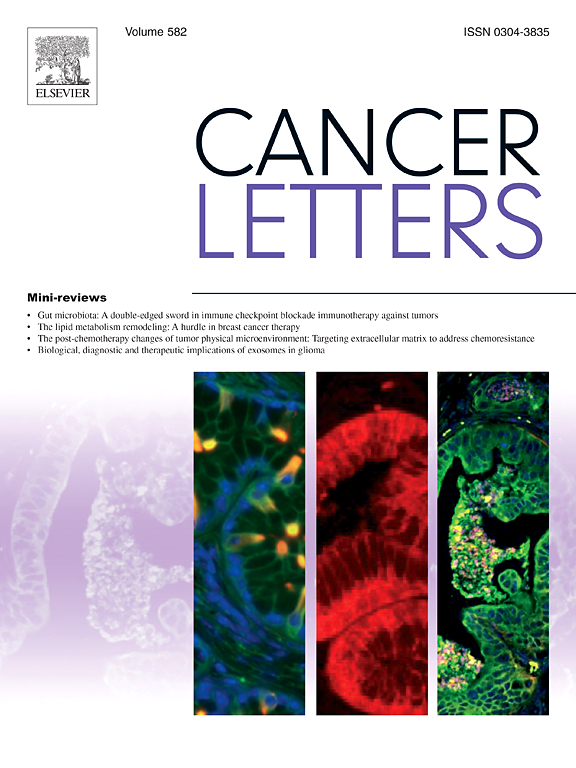核cGAS介导的复制应激和有丝分裂突变可以克服吉西他滨耐药性。
IF 10.1
1区 医学
Q1 ONCOLOGY
引用次数: 0
摘要
吉西他滨是一种核糖核苷酸还原酶(RNR)抑制剂,在胰腺导管癌(PDAC)患者中有活性,但不幸的是对长期预后的影响有限。吉西他滨诱导核苷酸缺陷,DNA损伤包括单链DNA (ssDNA)和复制应激(RS)。DNA损伤可激活环GMP-AMP合成酶(cGAS),导致基因组不稳定、微核产生和免疫激活。在模型系统中,吉西他滨耐药可以通过与共济失调毛细血管扩张和rad3相关抑制剂(ATRi; AZD6738)联合治疗来克服,该抑制剂阻断S和G2检查点,尽管潜在的机制仍有待完全阐明。我们发现,低基础RS的细胞对吉西他滨具有耐药性,可以通过与AZD6738联合治疗,通过提高RS、磷酸化- rpa32耗竭和PDAC细胞模型中的有丝分裂突变来克服这种耐药性。吉西他滨诱导独立于sting介导的免疫激活的核cGAS积累。核cGAS与γ - h2ax在双链DNA断裂(DSBs)上的结合在吉西他滨和AZD6738处理细胞的RS激活和有丝分裂突变中起关键作用。本文章由计算机程序翻译,如有差异,请以英文原文为准。
Nuclear cGAS mediated replication stress and mitotic catastrophe can overcome gemcitabine resistance
Gemcitabine, a ribonucleotide reductase (RNR) inhibitor, is active in pancreatic ductal carcinoma (PDAC) patients, but unfortunately has a limited impact on long term outcomes. Gemcitabine induces nucleotide deficiency, DNA damage including single stranded DNA (ssDNA) and replication stress (RS). DNA damage can activate cyclic GMP-AMP synthase (cGAS), leading to genome instability, micronucleus generation, and immune activation. In model systems, gemcitabine resistance can be overcome by combination treatment with the ataxia telangiectasia and Rad3-related inhibitor (ATRi; AZD6738) that blocks S and G2 checkpoints, although underlying mechanisms remain to be fully elucidated. We show that cells with low basal RS are resistant to gemcitabine, which could be overcome by combination treatment with AZD6738 through elevation of RS, phospho-RPA32 exhaustion, and mitotic catastrophe in PDAC cell models. Gemcitabine induces nuclear cGAS accumulation independent of STING-mediated immune activation. The binding of nuclear cGAS to γH2AX at double strand DNA breaks (DSBs) plays a pivotal role in RS activation and mitotic catastrophe in gemcitabine and AZD6738 treated cells.
求助全文
通过发布文献求助,成功后即可免费获取论文全文。
去求助
来源期刊

Cancer letters
医学-肿瘤学
CiteScore
17.70
自引率
2.10%
发文量
427
审稿时长
15 days
期刊介绍:
Cancer Letters is a reputable international journal that serves as a platform for significant and original contributions in cancer research. The journal welcomes both full-length articles and Mini Reviews in the wide-ranging field of basic and translational oncology. Furthermore, it frequently presents Special Issues that shed light on current and topical areas in cancer research.
Cancer Letters is highly interested in various fundamental aspects that can cater to a diverse readership. These areas include the molecular genetics and cell biology of cancer, radiation biology, molecular pathology, hormones and cancer, viral oncology, metastasis, and chemoprevention. The journal actively focuses on experimental therapeutics, particularly the advancement of targeted therapies for personalized cancer medicine, such as metronomic chemotherapy.
By publishing groundbreaking research and promoting advancements in cancer treatments, Cancer Letters aims to actively contribute to the fight against cancer and the improvement of patient outcomes.
 求助内容:
求助内容: 应助结果提醒方式:
应助结果提醒方式:


